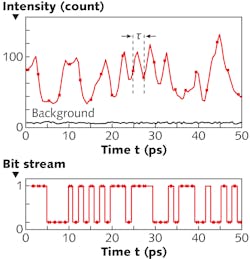Hourglass-shaped laser-diode cavity forms a parallel ultrafast random-bit generator

True random-number generators are essential for cryptographic data communications. While so-called pseudorandom numbers can be generated by software algorithms, cryptography built around such numbers can be deciphered with enough time because of the nonrandom basis of the number generation. In contrast, truly random numbers can be generated only by a setup based on a truly random physical process. In the past, these have included specially designed laser diodes coupled to silicon photonics, laser-based measurements of the quantum vacuum field, on-chip distributed-feedback (DFB) lasers, and superluminescent LEDs (SLEDs). Now, a new photonics-hardware-based random-bit generator has been developed by a world-spanning group of researchers from Yale University (New Haven, CT), CentraleSupélec and Université Paris-Saclay (Metz, France), Nanyang Technological University (Singapore), Imperial College London (England), and Trinity College Dublin (Ireland). The new device has the advantage of being ultrafast—on the order of 100 Tbit/s, which is two orders of magnitude faster than previous physical random-bit generators. Being chip-based, the device is scalable, robust, small, and energy-efficient.
The random-bit generator is simple, consisting of a single gallium arsenide/gallium aluminum arsenide (GaAs/AlGaAs) laser diode with a configuration allowing many spatiotemporally interfering lasing modes, resulting in spontaneous emission noise. The laser cavity has a narrow waist; combined with two larger cavity mirrors (end facets), each a segment of a circle, the 2D cavity looks like an hourglass with bulging ends. Two arrays of photodetectors, one beyond the end of each cavity mirror, also form circular arcs. The laser has a cavity length of 400 µm, end-facet radius of 230 µm, spatial-mode wavelengths ranging from on the order of 796 to 804 nm, and emission power per channel of 0.1 to 1 mW. In the experiment, rather than using photodetectors, a streak camera was used to examine the spatiotemporal interference of lasing modes; random-bit generation in 243 channels was demonstrated with 820 Gbit/s per channel. Reference: K. Kim et al., arXiv:2004.07157v1 [physics.optics] (Apr. 15, 2020).

John Wallace | Senior Technical Editor (1998-2022)
John Wallace was with Laser Focus World for nearly 25 years, retiring in late June 2022. He obtained a bachelor's degree in mechanical engineering and physics at Rutgers University and a master's in optical engineering at the University of Rochester. Before becoming an editor, John worked as an engineer at RCA, Exxon, Eastman Kodak, and GCA Corporation.